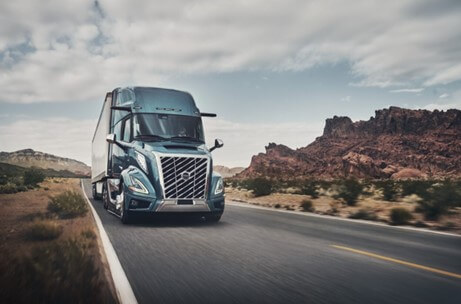Volvo Trucks North America has launched a completely reimagined Volvo VNL to set new industry standards in heavy-duty trucking and improve total customer value, driver productivity, safety and sustainability. The new Volvo VNL features striking aerodynamics and is engineered to achieve a fuel efficiency improvement of up to 10%. Sales will begin in the coming months with production at the Volvo Trucks New River Valley Plant in Dublin, Va.
“The all-new Volvo VNL was designed to change everything,” says Peter Voorhoeve, president, Volvo Trucks North America. “However, change doesn’t only come with a redesigned truck — this product introduction is the start of a new era for Volvo Trucks, our customers and their drivers — a quantum leap forward.”
The Volvo VNL will be the platform for all upcoming technologies, including future transportation solutions of battery-electric, fuel cell and internal combustion engines running on renewable fuels including hydrogen. The first 24-volt electrical infrastructure in the North American trucking industry and active safety features introduced in this new generation of Volvo trucks will be the standard for the future commercialization of fully autonomous trucks.
Development of these new Volvo vehicles focused on improvements in five key areas: fuel efficiency, safety, driver productivity, connected services and uptime.
The streamlined and more angular, wedge-shaped cab design of the Volvo VNL, featuring a dramatically redesigned windshield, is a key factor in achieving up to 10% improvement in fuel efficiency. Additional aerodynamic gains were created from the integration of the curved and bonded windshield, tighter clearances around turbulent air areas including wheel openings, the bumper and hood, and chassis fairings along with promoting a tighter trailer gap. These designs were developed and tested in parallel with Volvo Trucks’ SuperTruck 2.
Volvo Trucks engineers also made improvements to the powertrain offering. The Volvo VNL is powered by the latest generation D13 engine that delivers improved fuel efficiency, performance and durability. The D13 engine is available in four horsepower ratings, ranging from 405-500 hp and three torque ratings from 1,750-1,950 lb-ft of torque. These different power options are designed to suit different applications and incorporate the improved and optimized I-Shift transmission, which features up to 30% faster shift speeds. When combined with the I-Torque powertrain solution, the D13 can deliver even greater fuel savings, best-in-class versatility and drivability.
A variety of active safety systems are offered with the Volvo VNL, including Volvo Active Driver Assist Plus with Pilot Assist that provides active lane centering. Volvo Active Driver Assist Plus is powered by Volvo Dynamic Steering, which improves maneuvering at all speeds, including more controlled backing; increases stability at all road speeds; and adapts and corrects for crosswinds, highway crowning, soft shoulders or emergency situations such as tire failure. The new pedestrian detection feature alerts the driver when a pedestrian or bicyclist may be in their path or blind spots and will activate frontal automatic emergency braking for objects directly in the path of travel.
Passive safety systems offered in the Volvo VNL include the bonded and wrapped windshield providing panoramic views. This not only improves aerodynamics for the Volvo VNL, but it also improves visibility for drivers, bolstering safety and reducing wind noise in the cab.
The cab of the Volvo VNL is designed according to Volvo Trucks’ crash test standards and will offer a side-curtain airbag, with options for driver-only or driver and passenger airbags, a North American industry first. Cabs are constructed of high-strength steel to deflect the energy of a crash to reduce the chance of injury. Additionally, Volvo Trucks’ flared frame rails allow the powertrain to drop down below the cab to protect the driver. E-Call, a new safety feature, connects the driver to emergency services where cellular connectivity is available and provides precise location details. This occurs automatically in the event of a rollover crash or airbag deployment.
The Blue Service Contract, an optional, comprehensive dealer managed service plan, leverages Volvo’s connected services to boost uptime and efficiency. By utilizing Volvo’s connected services, dealers have real-time data when maintenance is due and diagnostic information for any detected fault codes.This enables the customer to schedule service in advance and have dealers perform remote programming updates to maintain the health of the truck and prevent unplanned downtime. During dealer afterhours, Volvo Trucks’ Uptime Center continues to remotely monitor the truck and will alert plan subscribers if any critical issues arise.
Volvo Trucks North America’s new 24-volt electrical architecture, the first in North America, helps to minimize battery and electrical failures and improve serviceability when it comes to pinpointing and repairing electrical issues. A new linear exhaust aftertreatment system will be easier to service and deliver better DEF treatment for an even cleaner system.
The Volvo VNL is conveniently packaged into four exterior and interior trim levels — Core, Edge, Edge Black and Ultimate — with six cab configurations:
- VNL 300 Day Cab
- VNL 440 42-inch Mid-Roof Sleeper
- VNL 640 62-inch Mid-Roof Sleeper
- VNL 660 62-inch Full-Height Sleeper
- VNL 840 74-inch Mid-Roof Sleeper
- VNL 860 74-inch Full-Height Sleeper
Training will be available to dealer sales staff to enable them to consult with customers on the ideal Volvo VNL configuration for their transport applications. Dealers’ service representatives have access to extensive competency development, with e-learning and in-person instructor-led courses from Volvo Academy, to be fully trained to support the new Volvo VNL when trucks start to arrive at dealerships.




